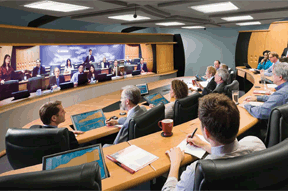After A Year Of Acquisitions, Videoconferencing Finds Its Stride In 2010
On-screen meeting participants are shown in true-to-life dimensions in Polycom’s immersive telepresence solutions. Participants can speak with and read the body language of others—just as if all were in the same room.
Videoconferencing had a banner year in 2009. Nearly every IT company is touting its real-time collaboration tools, like Google Wave and HP Halo. Mainstream media covered the big business trends in executive telepresence, hyping not only the Next Big Thingness but the C02 and cost savings for travel-weary executives.
Companies such as Tandberg, Cisco, LifeSize, Polycom, and ClearOne, have ramped up R&D to create lifelike, high-definition video communication that’s as easy and intuitive as a telephone call.
Cisco telepresence has appeared in TV shows like CSI and 24 and is installed in or used by global companies like Procter & Gamble, GE, HSBC, Staples, and universities such as UCLA and MIT.
Solutions are becoming available for more applications. Growth in the high-end is steady, as bids circulate for “white glove” immersive telepresence rooms. Mid-level projects are also growing in smaller meeting rooms for enterprises and educational facilities.
Entry-level integrators are also seeing sales increase. As interoperability and bandwidth increase, and new gateways bridge the gap across formats, contractors are reporting opportunities in the “entry level” of videoconferencing integration, by connecting office desktops and telecommuters in their home offices.
- CHANNEL CONSOLIDATION
- The considerable consolidation of 2009 may reshape the videoconferencing landscape with new synergies and broader product lines. Of note are Cisco’s acquisition of Tandberg, ClearOne’s attainment of Net- Streams, and Logitech’s purchase of LifeSize Communications. Polycom is shipping product line additions that add versatility for the telepresence integrator across vertical markets.
What’s the logic behind Logitech’s purchase of LifeSize Communications? It’s all about taking HD-quality video communication mainstream, the company says. Logitech is a Swiss company that provides PC video communication products, while U.S.- based LifeSize supplies HD video for workplace collaboration. LifeSize says it has more than 9,000 videoconferencing customers across 80 countries in large enterprises, smallto- medium businesses (SMB), and education, public healthcare, and the government.
Logitech claims the synergies between the two companies—including HD web cameras, firewall traversal, bandwidth management, and video compression—will help drive growth for the SMB and enterprise markets.
User friendliness and interoperability are the key components of the strategy for Gerald P. Quindlen, Logitech president and CEO. He told the press: “Through our combined strengths in high-definition, highquality webcams, ease of use, and interoperability, we plan to capitalize on this opportunity by delivering disruptive price/performance offerings to the market.”

With the same features and options as the Telepresence T3, Tandberg’s Telepresence T1 is designed for smaller spaces and meetings.
What’s the synergy between ClearOne and NetStreams? IP is the answer. NetStreams is a small company in Texas that offers expertise in distributing high-definition audio and video over TCP/IP networks. ClearOne, a much larger company, develops audio conferencing systems and other related products for audio-, video-, and webconferencing applications. Together the company hopes to bring more reliable high-def TCP/IP videoconferencing systems into the next generation.
DRIVING GROWTH
There is no substitute for face-toface meetings; they are key to forming and sustaining relationships. Similarly, there’s no replacement for the affirmation of a handshake to mark a contract. But for the widest spectrum of collaboration, communication, audits, supply-chain interactions, and project needs, videoconferencing fits the bill. With high-resolution video, facial expressions and eye contact are present. In some cases of a megalarge screen, facial expressions are even larger than life.
For team management, daily or weekly “check ins” on status, and making initial introductions, videoconferencing is promoted as an alternative to in-person meetings. Just ask folks who commute from LA to San Francisco or New York to Boston every week, what they would choose?
“We are video enabling entire enterprises,” said Rick Snyder, president of global businesses, Tandberg. “The traditional conference room is changing.”
“If you can reduce time to market and improve supply chain relationships, the investment in videoconferencing pays for itself,” stated Erica Schroeder, director of market management, Cisco. And as the economy improves, global corporations aren’t just looking for ways to save money on travel costs, they are looking for ways to optimize international operations and empower their satellites.
Tandberg believes that the combined force of its portfolio and Cisco’s will “broaden and deepen the HD-enabled product lineup and infrastructure solutions” for telepresence, Synder added.
Videoconferencing in the medical field, colloquially known as telemedicine, is growing at an impressive clip due to myriad factors, but mostly, companies say, because of the immediacy and convenience of the technology. More than 3,500 hospitals and clinics in the United States now have videoconferencing systems, up from about 2,500 in 2007. Surgical suites are linked into immersive telepresence for educational purposes. They also provide encryption for security of data.
VOICE AND VIDEO
Mobile video is another trend motivating the investment in the technology, synergies, and interoperability between Cisco and Tandberg. Synder believes that the synergies will broaden the category of videoconferencing—to “democratize video”—all the way from telepresence to CTS platforms to executive appliances and desktops.
Cisco has sold millions of IP telephony systems, and Synder believes there will be more interoperability in the next few years.
“Mobile video is becoming more popular,” echoes Cisco’s Erica Schroeder. She described a new innovation from the company, the Flip camera, which lets users instantly access video and upload with no need for cables or set up. It’s not a business- to-business application, but it is a signifier of how easy and mainstream high-quality video can be. Cisco says the acquisition of Pure Digital, maker of the Flip, is key to its strategy to expand momentum in the media-enabled home and to capture the consumer market transition to visual networking.
“Cisco is a bellwether for trends to come,” Schroeder said, and as such, its steady telepresence growth suggests that video-to-video communication with high quality sound will become the default. “Anything less than telepresence is not satisfying,” she said.
Additionally, solutions that tackle the big barriers to videoconferencing in the past—differing formats, lack of interoperability—will help the category grow. “Worrying about formats constrained industry innovation,” Schroeder explained. “Systems contractors can build telepresence proficiencies in 2010 without the complexities [of competing formats]. We can now develop more vertically relevant applications and more tools to solve business problems,” she added.
From MS Office users to proprietary systems users, the real power, and indeed real promise for integrators and manufacturers, is “connecting everyone,” Tandberg’s Rick Snyder said. “The collaboration market is $34 billion dollar market, and growing,” he added.
Creating more business tools is exactly what Polycom intends to do with its new generation of immersive telepresence solutions. Laura Shay, Polycom director of product marketing, says that the company’s solutions offer enhanced versatility and deployment flexibility, so clients can get the most out of their investment. Polycom believes so much in ROI that they have an ROI calculator right on their website so companies instantly see the metrics.
Polycom immersive telepresence products include the Polycom RealPresence Experience (RPX) line provides a “same room” collaboration experience for up to 28 people in each location.
The Polycom Telepresence Experience (TPX) line provides an “acrossthe- table” experience for meetings, while the Architected Telepresence Experience (Polycom ATX) is a customizable kit that can be adapted for specific room environments and unique application requirements. AV systems integrators will have a new level of customization with the ATX, Shay added. Polycom also offers room telepresence products for small to large meeting rooms, and personal products for executive offices and desktops.
Shay said the broad range and flexibility changes the game in terms of its seamless integration. “Transparent technology,” Shay elaborated, is part of the innovation. Associates can see “facial expressions, make eye contact, and read body language,” she added.
As solutions have grown and market acceptance and deployment increases, Polycom has added different options for how to manage client systems. “As our partners became more and more familiar [with the technology], some clients, like the federal government, say that they want their own IT operations center,” she said. “Some users don’t want any interface, others want other it. It is now more ad hoc rather than a highly managed experience.” Contractors can choose from scalable multi-site, multi-network conferencing capabilities, network- aware firewall traversal, recording, and streaming and video content management for the ultimate in-house marketing tools.
The big achievement is interoperability with other standards-based immersive telepresence systems, and legacy video equipment.
As an integrator, Shay said, there is no better time to build video into your service offerings. “Vendors like Polycom are adopting standards of other providers like Microsoft— maybe it happens in a bridge and transcoder—so everything plays nicely together, or works point to point.”
Upgradeability and expandability is essential for professional AV integrators, she says. “Five years from now, will your client want to talk to someone outside of a proprietary system? You want to meet their needs long into the future.”
Margot Douaihy has covered the systems integration industry for the past decade as contributing editor for Residential Systems and frequent contributor to SCN.

